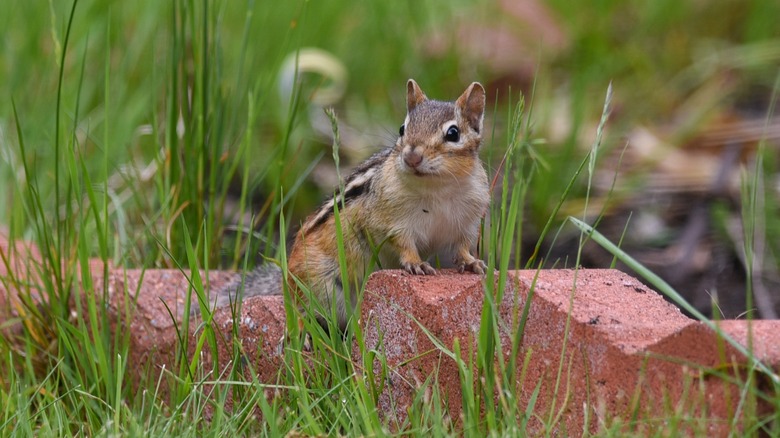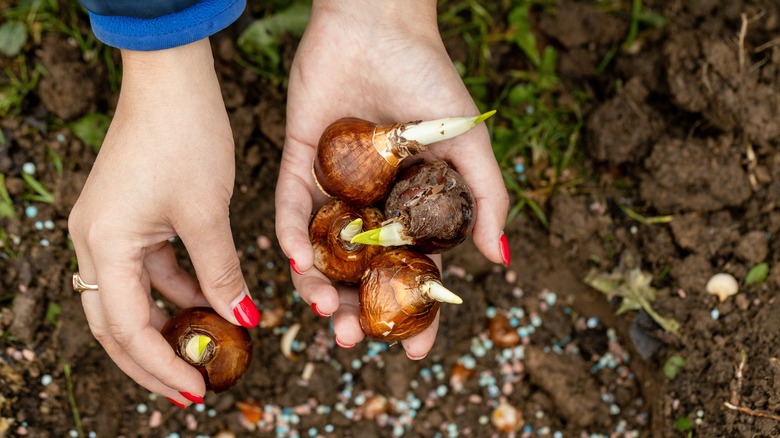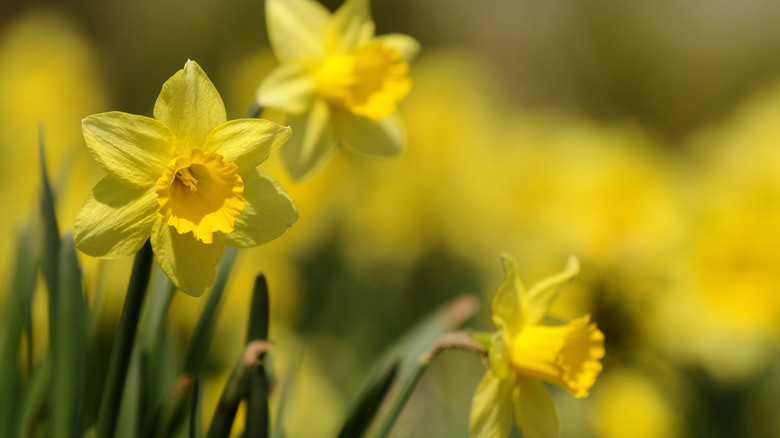The Bright & Cheery Flower That Doubles As An Easy Chipmunk Repellent
Chipmunks may be cute, but they can sure cause a headache in the garden. Since they have appetites for seeds, mushrooms, bulbs, and bugs, you can find them skittering through your garden looking for food to store away for later. Chipmunks seem to enjoy crocuses and tulips the most, so if you enjoy having a garden full of them and live in the eastern U.S., you're likely to see a chipmunk. They aren't as common in the central or western states, and you'll rarely see them in the southern states. If you do have a chipmunk problem, try planting daffodils. Even though daffodils have bulbs, chipmunks usually avoid these. This could be due to the lycorine they contain, which is toxic and can be lethal when consumed by both chipmunks and humans.
Chipmunks may still dig up daffodils, but they won't want to eat them. The daffodil bulbs can function as a repellant and may keep chipmunks away altogether. Even if those pesky critters do dig them up, you'll at least still have them and will be able to replant them. It's annoying, but it's better than finding yourself bulb-less! You can create a gorgeous flower bed of tulips and daffodils in areas where chipmunks are a problem to help ward them off. Though they want the tulips, the daffodils may make them change their mind.
What makes daffodils so intolerable
Daffodils are beautiful flowers, but they contain some gnarly toxins that aren't safe to touch or consume. One of them is lycorine, an alkaloid found in different plants in the Amaryllidaceae family, including daffodils and surprise lilies. It's typically understood that large quantities are harmful, though a letter in the Acute Medicine & Surgery journal relays a story of a family who accidentally cooked daffodil bulbs instead of onions. They thought the onions were too bitter and spit them out, but the family soon had to go to the doctor due to nausea and vomiting. There isn't much research available about whether chipmunks are aware of the danger, but the bitterness would understandably be a turn-off.
If it isn't the flavor or nausea that keeps chipmunks out of your garden, it could be the "daffodil itch." If you've ever planted daffodil bulbs, you may be familiar with the itchy feeling it can leave behind. They contain oxalates in their sap and bulbs that can cause skin irritation. The effect can vary from person to person, but it often leaves a rash or a burning sensation. It affects people and animals, so chipmunks probably know to leave daffodil bulbs alone when they dig them up.
Using daffodils to keep chipmunks away
Because daffodils have so many unpleasant side effects, they're often used as chipmunk and rat repellent, and are also said to be useful against most other rodents and even snakes. If you want to use them in your garden, take some time to plan out where you want them and whether or not it will be safe to do so. Daffodils can harm people and pets, and the ASPCA notes them as toxic to dogs, cats, and horses. Plant them in areas where children and pets won't be able to access them easily, especially if they enjoy digging in the dirt.
Interplant daffodils with garlic and onions since alliums also repel chipmunks. Placing these plants near the ones chipmunks do want will create an unpleasant environment and will prevent chipmunks from invading the area. Should you have persistent chipmunks that insist on digging up your daffodils, you can use ½-inch galvanized steel hardware cloth to create physical barriers for your bulbs. This cloth can be found at hardware stores like The Home Depot. You can create a cage to bury with the bulb, or you can cover the entire bed so the chipmunks can't dig. You can use these methods for any bulbs you plant.


